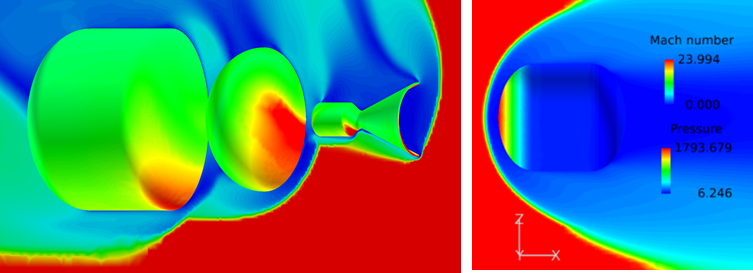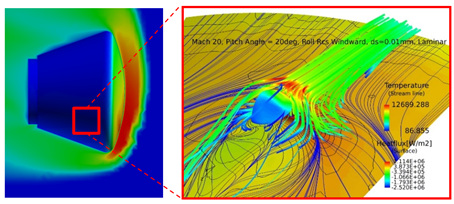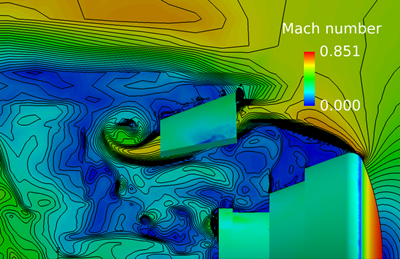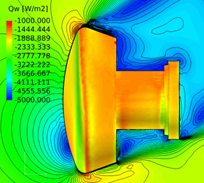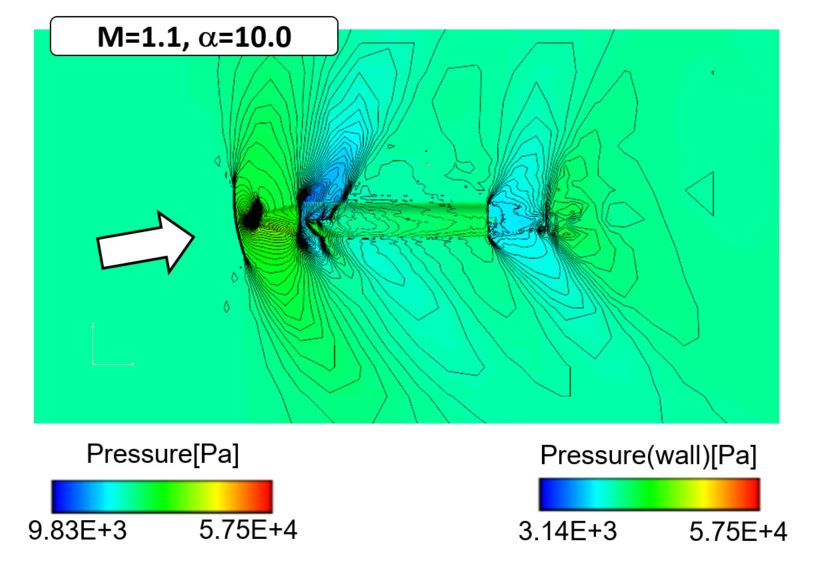Quantitative safety analysis technology by high-fidelity numerical simulation
JAXA Supercomputer System Annual Report April 2016-March 2017
Report Number: R16E0085
- Responsible Representative: Eiji Shima(Research Unit III Research and Development Directorate)
- Contact Information: Keiichiro Fujimoto(fujimoto.keiichiro@jaxa.jp)
- Members: Hiroaki Amakawa, Taisuke Nambu, Tomoyuki Deura, Takayuki Ito, Hideyo Negishi, Yoichi Ohnishi, Miki Nishimoto, Yu Daimon, Hiroshi Ishihara, Ashvin Hosangadi, Jeremy Shipman, Masaaki Ino, Jai Singh Sachdev, Osamu Fukasawa, Shinji Ohno, Andrea Zambon, Takenori Nakajima, Yuka Akimura, Takashi Amemiya, Hironori Fujiwara, Hiroumi Tani, Takuya Iimura, Keiichiro Fujimoto, Tetsufumi Ohmaru, Akiko Kotani, Taroh Fukuda, Mayu Matsumoto, Masashi Toyama, Yuki Ide, Shohta Sutoh, Takaaki Kishi
- Subject Category: Space(Rocket,Space transportation)
Abstract
In order to perform detailed destructive re-entry safety analysis and to obtain the validation data for the empirical models, the aerodynamic and heat flux analysis under the wide range of flow conditions based on the developed rapid turn-around CFD method is carried out. In addition, by using the developed tools, the aerodynamic and heat flux design analysis are conducted in order tosupport the research and development activities for the small re-entry capsule installed in HTV and the fly-back re-usable rocket.
Goal
By employing multi-disciplinary coupling analysis based on the high-fidelity numerical simulations, new quantitative safety analysis method is under the development.
Objective of this study is that by reducing uncertainty on the safety analysis, further improvement in the safety for the space debris problems with keeping the international competitiveness of the performance.
Objective
For the practical use of the high-fidelity numerical simulations in the safety analysis, analysis turn-around time aimed to be reduced by half. Then, new destructive re-entry safety analysis method will be developed, and it would contribute to realize the ease of the safety limitations.
References and Links
Please refer ‘JEDI Center(JAXA’s Engineering Digital Innovation Center)‘.
Use of the Supercomputer
Perform hundreds of the aerodynamic and heat flux analysis for the wide range of flow conditions.
Necessity of the Supercomputer
Accurate high-fidelity numerical simulations for the complicated physics under the wide range of conditions is essential for the quantitative safety analysis. In addition, the analysis methods and its results are high-level confidential information. Therefore, high-performance own supercomputer system is essential.
Achievements of the Year
In the conventional re-entry safety analysis, the aerodynamic and heat flux models with conservative assumptions are used, and the system shape is treated as the combination of the simple geometries such as the sphere and the cylinders. Due to these conservative assumptions, the predicted risk is generally resulting in the conservative risk which includes the various margins. To meet the challenging safety requirement in the near-future by the design for safety at the early design stages, an establishment of the new destructive re-entry safety analysis method based on the high-fidelity numerical simulations is essential. Therefore, the detailed CFD analysis for the destructive re-entry of the rocket upper stage and the propellant tank is conducted. Computed results are used to understand the related flow mechanism and to validate the empirical correlation models which is currently used in the safety analysis. Computed heat flux for rocket upper stage and the pressure for propellant tank are shown in Fig. 1.
Research and development activities to realize next generation space transportation and re-entry systems such as the small re-entry capsule installed in HTV and the re-usable fly-back booster are under the way at JAXA. In the aerodynamic design studies for such vehicles, large-scale parametric CFD analysis under the wide range of flow conditions is essential. Aerodynamic analysis is the most time-consuming process which is the bottle-neck for the conceptual design and the probabilistic analysis. In this study, rapid turn-around time CFD tool (LS-FLOW) is employed for such parametric studies.
For the development of small re-entry capsule installed in HTV, the aerodynamic and heat flux prediction including the RCS jet and main stream interaction, the capsule outer shell separation behavior before the parachute deployment, and the cooling effect by low temperature air flow for the thermal design of the vehicle are analyzed. In all analysis, there should be large scale parametric CFD study is required to consider the various uncertainties on the environmental conditions.
For the aerodynamic design of the fly-back booster demonstrator, large scale parametric CFD study of various configuration under the wide range of flow conditions is conducted.
By the application of the developed CFD tool, large scale parametric CFD analysis becomes available, which is the key for the success of the next generation space transportation and the re-entry vehicles.
Publications
Peer-reviewed articles
1) Keiichiro Fujimoto, Hiroumi Tani, Hideyo Negishi, Yasuhiro Saito, Nobuyuki Iizuka, Akira Kato and Koichi Okita, ‘Uncertainty quantification strategy for destructive reentry safety analysis,’ Stardust Final Conference – Advances in Asteroids and Space Debris Engineering and Science, Springer (to be published).
Non peer-reviewed articles
1) Fujimoto K., Taisuke N., Negishi H. et. al., ‘Validation of LS-FLOW for Reentry Capsule Unsteady Aerodynamic Analysis,’ AIAA Paper 2017-1411, 2017.
2) Ryuta Hatakenaka, Kazuhiro Miyazaki, Yasuhide Watanabe et. al., ‘Thermal Design of Small Sample-Return Capsule Integrated into HTV,’ ICES 2017, 2017 (to be published).
3) Keiichiro F, Yasuhiro S, Ryuzo Set. al., ‘Overview and Progress of Research on Space Debris in JAXA,’ Stardust Final Conference on Asteroids and Space Debris, 2016.
4) Keichiro F, Hiroumi T, Hideyo Net. al., ‘Update of Aerodynamics and Heat Flux Model for ORSAT-J,’ 8th IAASS Conference, 2016.
Computational Information
- Parallelization Methods: Process Parallelization
- Process Parallelization Methods: MPI
- Thread Parallelization Methods: n/a
- Number of Processes: 512
- Number of Threads per Process: 1
- Number of Nodes Used: 16
- Elapsed Time per Case (Hours): 120
- Number of Cases: 172
Resources Used
Total Amount of Virtual Cost(Yen): 28,063,691
Breakdown List by Resources
| System Name | Amount of Core Time(core x hours) | Virtual Cost(Yen) |
|---|---|---|
| SORA-MA | 16,951,530.44 | 27,640,766 |
| SORA-PP | 738.81 | 6,307 |
| SORA-LM | 0.00 | 0 |
| SORA-TPP | 4,011.43 | 59,148 |
| File System Name | Storage assigned(GiB) | Virtual Cost(Yen) |
|---|---|---|
| /home | 387.91 | 3,659 |
| /data | 21,902.80 | 206,609 |
| /ltmp | 15,499.84 | 146,210 |
| Archiving System Name | Storage used(TiB) | Virtual Cost(Yen) |
|---|---|---|
| J-SPACE | 0.32 | 988 |
Note: Virtual Cost=amount of cost, using the unit price list of JAXA Facility Utilization program(2016)
JAXA Supercomputer System Annual Report April 2016-March 2017



